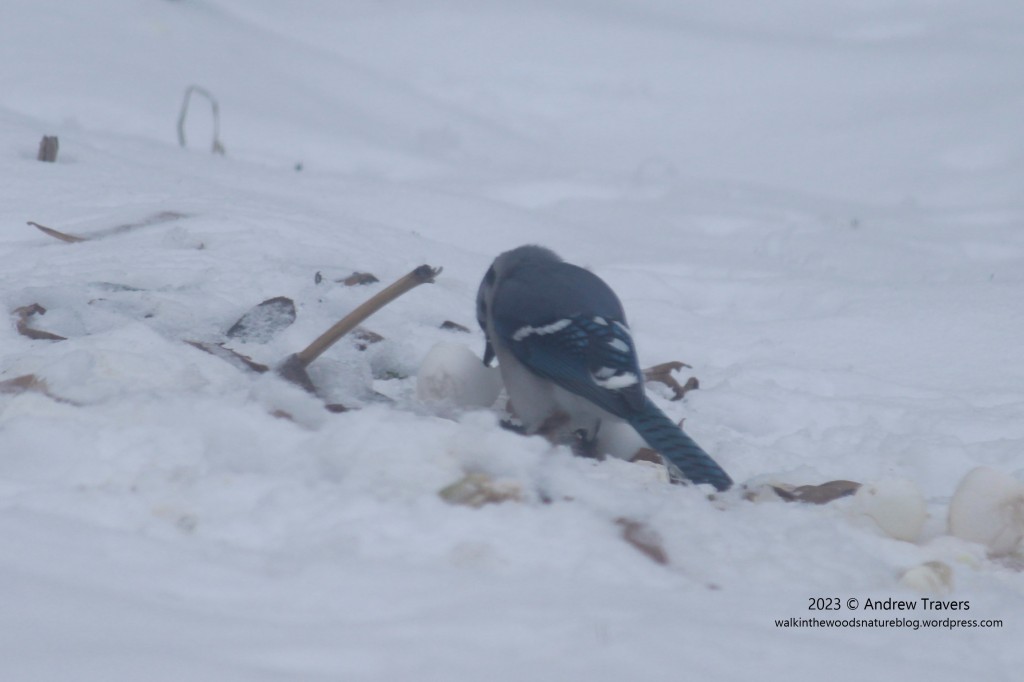A quick note, this post will not be about the Attwater’s Prairie Chicken. In my last post, I said I would cover their captive breeding program. However, my research for that post has been postponed due to the ending of my current position and the search for the next position.
Instead, here is one that I had already written up. Instead of a prairie chicken, it instead covers a bird I’m sure most people in the United States are familiar with.

The Blue Jay.
This individual was photographed a couple of years ago. It had dug through the snow to reach some food scraps that had been thrown out by my family. The Blue Jay (Cyanocitta cristata) occurs east of the Rockies, from southern Canada south to the Gulf of Mexico. It is present in most of this range year-round, although individuals in the northern part will withdraw during the winter1, 2.
The Blue Jay often inhabits oak and pine forests, as well as suburban gardens, groves, and towns. It is becoming common in well-wooded suburbs and city parks. Habitat with oak or beech trees is preferred by these birds. These birds are omnivorous, although their diet mostly subsists of vegetable matter. This can come in the form of acorns and beechnuts among other nuts, many kinds of seeds, grains, berries, and fruit. Animal matter consists of mostly insects, but these birds will also eat spiders, snails, and other birds’ eggs. They will every now and then consume small rodents, frogs, baby birds, and carrion2.
While its commonly heard sound (often described as sounding like jay jay) isn’t beautiful, the same can’t be said for the bird itself. With its blue back, interspersed with white and black spots, a white belly, and a prominent crest, many wouldn’t call this bird ugly.
What many may now know is that Blue Jays have a variety of sounds. Estimates include 203 and 424 unique sounds. The purpose for these calls is just as varied, with some used to identify threats, to keep in touch with other Blue Jays, courtship, and young birds begging their parents for food4.

During the breeding season, Blue Jays emit another type of call: imitation calls4. Surprisingly, this bird is also an amazing mimic. Its repertoire includes:
- Red-shouldered Hawk2, 4
- Broad-winged Hawk2, 4
- Red-tailed Hawk4, 5
- Crows3, 4
- Bald Eagle4
- Cooper’s Hawk4, 6
- Ring-billed Gull5
- A researcher’s pet Siamese cat3
Interestingly, the only calls that blue jays imitated were those of predators that were present in the same area as the individual blue jay. This means that a blue jay in the middle of the forest without any cats around wouldn’t mimic a cat’s meow. This suggests that these calls are learned by the Blue Jays4. They don’t instinctively know them.
The reason behind Blue Jays mimicking their predators is still not well understood. One theory is that these calls could be an attempt to deceive the predator, say a Red-shouldered Hawk, into thinking another hawk is in the area. The predator would then shift its focus from hunting the Blue Jay to instead dealing with the trespassing hawk4.

Other theories could be to warn other Blue Jays about the presence of a predator, or a previous sighting of a predator. A third, and less noble, theory is that Blue Jays emit these mimicked calls to deceive the mimicked predators’ potential prey, frightening them away from a resource desired by the Blue Jay, such as a bird feeder5.
What is interesting to note is that, since these calls are learned by the Blue Jays, it is possible that birds in different flocks associate certain calls with different contexts or situations4. The answer may be, all the above.
If you want to read about another animal that mimics another species, click here!
If you want to read about another bird found in the scrap pile, click here!
Bull, John and John Farrand, Jr. National Audubon Society Field Guide to North American Birds: Eastern Region Knopf, New York: 19941
“Blue Jay Cyanocitta cristata” Audubon <https://www.audubon.org/field-guide/bird/blue-jay> Accessed 5 November 20202
Conant, S. 1972. Visual and acoustic communication in the Blue Jay (Cyanocitta cristata). Ph.D. dissertation, University of Oklahoma, Norman, OK3
Brewer, Dustin Eric, “Characteristics, contexts, and possible functions of the vocalizations of Blue Jays” (2016). Online Theses and Dissertations. 347. https://encompass.eku.edu/etd/3474
James, Ross D. 2002. “Of Blue Jays and Mimicry.” Ontario Birds 20(1): 7-125
Hailman, Jack P. 2009. “Context of Blue Jay (Cyanocitta cristata) Mimicking Cooper’s Hawk (Accipiter cooperii) Cackle.” Florida Field Naturalist 37(3): 94-956


Leave a comment